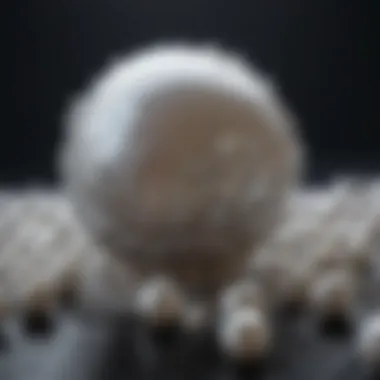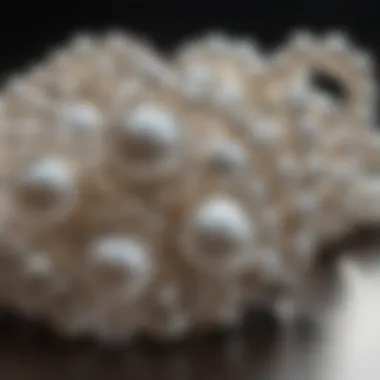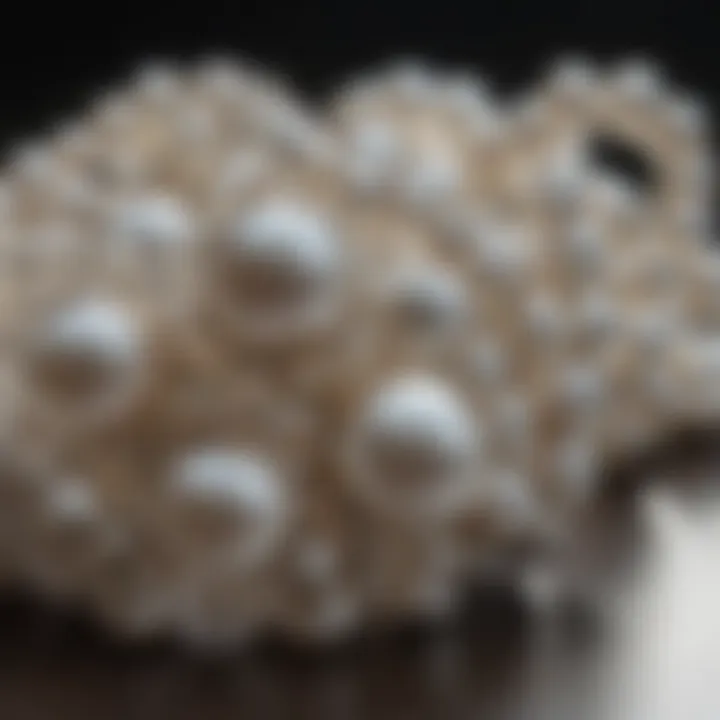Unlocking the Worth of Freshwater Pearls


Intro
When one thinks about luxury, pearls certainly come to mind, casting a silent spell of elegance and sophistication. In particular, freshwater pearls present a unique allure, distinguished by their gentle luster and diverse range of colors. Unlike their saltwater relatives, these gems grow within freshwater mussels, leading to an organic variety that's something of a marvel in the jewelry world. Whether you’re a collector, designer, or simply interested in understanding these exquisite gemstones further, the question of their valuation is both intriguing and vital.
This article delves into the myriad factors that influence the worth of freshwater pearls. It goes beyond surface appreciation to examine the intricate processes of pearl formation, key quality indicators, and the complexities of market trends. Additionally, it explores the cultural significance of these gems, immersing the reader in both history and ethics associated with pearl sourcing.
Gemstone Overview
Freshwater pearls are not merely beautiful objects; they embody the fascinating processes of nature and human cultivation alike. To appreciate these gems fully, one must first grasp their definitions and classifications.
Definition and Characteristics
Freshwater pearls are formed inside the shells of freshwater mussels, primarily in lakes, rivers, and ponds. Unlike saltwater pearls, which form within oysters, freshwater pearls can develop in a variety of colors and shapes, largely due to their unique environment and the types of mussels involved in their creation. These pearls are generally round or semi-round, but they can also be found in slightly irregular shapes, which can add to their charm and individuality.
Classification of Freshwater Pearls
Freshwater pearls can be categorized based on several factors:
- Shape: Round, baroque, and drop-shaped pearls are common variations.
- Color: These gems display a spectrum of hues ranging from white and cream to pink, lavender, and even dark hues.
- Luster: The intensity and quality of the pearl's shine highlight its beauty and desirability.
Understanding these classifications is the first step toward recognizing the full value of freshwater pearls.
Properties of Gemstones
In examining freshwater pearls, it’s crucial to delve into their physical and chemical properties, as these attributes significantly influence valuation.
Physical Properties
The physical properties of freshwater pearls encompass features like size, shape, and surface quality. Larger pearls generally command higher prices, but the overall appearance is what truly captivates.
- Size: Generally measured in millimeters, larger pearls often fetch a premium.
- Surface Quality: Pearls free from blemishes, spots, or imperfections signify higher quality.
Chemical Properties
The chemical composition of freshwater pearls, primarily consisting of aragonite and conchiolin, also impacts their durability and aesthetic appeal.
"The quality of freshwater pearls is not just in their beauty; it lies in the intricate dance between nature and nurture."
Pearls display peculiarities that allow for various techniques to assess their genuineness, such as the surface texture and weight. These elements build a clearer picture of what defines their worth in the marketplace.
From here, we will dive deeper into the market trends, pricing strategies, and other influences impacting the quality and value of freshwater pearls.
Intro to Freshwater Pearls
Freshwater pearls have carved a niche for themselves in the realm of gemstones, not only because of their aesthetic appeal but also due to their rich historical context and unique formation processes. Understanding freshwater pearls goes beyond mere appreciation of their beauty. It encompasses a deep dive into their value, both emotional and financial, and the multiple factors that contribute to their status as cherished items among jewelry enthusiasts and collectors alike.
These pearls originate from freshwater mussels and bring with them a character distinct from their saltwater cousins. Grasping their definition is crucial for anyone venturing into the world of pearls, as it lays the foundation for understanding their characteristics, quality indicators, and market dynamics. Unlike the more familiar ocean pearls, freshwater varieties provide a mix of affordability, variety, and accessibility, making them increasingly popular in modern jewelry design.
Additionally, this section serves to highlight not just the physical attributes of these luminous gems, but also their cultural significance across different societies. Appreciation for freshwater pearls has shifted over time, influenced by market trends, technological advancements in cultivation methods, and evolving consumer preferences. Consequently, the journey into the domain of freshwater pearls offers a comprehensive understanding of their role in both personal adornment and societal values.
As we delve deeper, we’ll explore definitions and characteristics to paint a clear picture of what freshwater pearls entail, followed by an examination of how they are formed. This exploration primes readers to better appreciate their unique qualities and the underlying processes which contribute to their worth in today’s market.
Definition and Characteristics
Freshwater pearls are a type of pearl created within freshwater mollusks, primarily mussels. Unlike saltwater pearls that grow in oysters, freshwater pearls are generally considered to be more versatile and varied in terms of size, shape, and color. They commonly range from round, oval, to baroque shapes, with the latter adding a sense of whimsy to jewelry design.
The luster of freshwater pearls – their ability to reflect light – can vary significantly; some pearls exude a soft glow, while others appear to sparkle with a vivid shine. This luster, along with surface quality, plays an integral role in determining their overall grading. Additionally, color can range from the classic white and cream to more exotic shades such as lavender, peach, and even dark hues. Each pearl tells a story not only of its physical formation but also of regional variations and cultivation techniques.
"The diversity in color and shape is a key characteristic that makes freshwater pearls particularly appealing to artists and jewelry designers as they can mix and match in designs while still maintaining an element of uniqueness."
Formation Process
The formation of freshwater pearls is a natural process that occurs when an irritant, often a parasite or LIVING organic matter, enters the shell of a mussel. In response to this irritant, the creature secretes layers of nacre – a combination of aragonite and conchiolin – to surround the irritant. Over time, these layers build up, forming a pearl. Unlike saltwater pearls that typically form around a bead nucleus, most freshwater pearls develop entirely from nacre.
This process can take anywhere from several months to a few years, depending on environmental conditions and the mussel species. The freshwater ecosystem, combined with the age of the mollusk, affects the eventual size and shape of the pearl produced.
This fascinating natural phenomenon doesn't just make each pearl unique; it creates a deeper appreciation of the biological and geological factors at play. Understanding the formation process of freshwater pearls provides valuable insight into their intrinsic value and the implications for collectors and enthusiasts alike.
As we continue through this article, we’ll delve into the historical significance and evolving worth of freshwater pearls, revealing how their journey from mussel to jewelry box has shaped their place in modern adornment.


Historical Context of Freshwater Pearls
The exploration of freshwater pearls is richer when it’s rooted in their historical context. These fascinating gems have traveled through time, adapting to various cultural landscapes while simultaneously impacting those cultures. Observing the trajectory of freshwater pearls provides insight into their valuation, both monetary and sentimental, making it essential to grasp this historical journey.
Cultural Significance
Freshwater pearls have been woven into the fabric of societies across the globe for centuries. In many cultures, they symbolize purity, integrity, and wealth. They have decorated the necks of emperors and adorned the fingers of brides, signifying love and commitment. In traditional Chinese culture, pearls were believed to bring wisdom and protection, often associated with royalty and divine beings.
Across various regions, the role of freshwater pearls has shifted and evolved. For instance, in ancient Rome, pearls were symbols of ultimate luxury, but in the Middle Ages, many regarded them as talismans that brought good fortune. This duality illustrates how the perception of pearls is tied closely to cultural values and historical contexts.
Moreover, the stories and myths surrounding these gemstones are as intriguing as the pieces themselves. In some Native American traditions, freshwater pearls were used in ceremonies, valued not just for their aesthetic appeal but also for their spiritual attributes. This ties back to the idea that these gemstones hold significance far beyond mere adornment.
Evolution of their Worth
When delving into the evolution of freshwater pearls' worth, one unveils an intricate tapestry interwoven with trading dynamics, environmental factors, and cultural shifts. Initially, pearls were scarce and highly coveted, often reserved for elite classes. The introduction of techniques to cultivate freshwater pearls in the late 20th century significantly changed their market value.
In the 1980s, the advent of mass cultivation brought an influx of freshwater pearls into the market. This accessibility made them more affordable but also sparked debates about authenticity and value. As cultivated pearls surged, the worth of natural pearls grew in distinction, creating a tiered system of valuation based on rarity and origin.
Today, factors such as quality, luster, and uniqueness can influence a pearl's market value more than mere supply and demand. Furthermore, the global focus on sustainability has led to an increased appreciation for ethically sourced pearls. Collectors and consumers are now not just looking for price tags; they seek stories, provenance, and value that resonate with their ethical standards. This shifting paradigm means that the true worth of freshwater pearls is often determined by narratives and the cultural appreciation that surrounds them.
"The journey through history reveals that the worth of freshwater pearls is not solely defined by their market price but by their cultural significance, the stories they tell, and the values they represent."
Though pearls have undergone tremendous shifts through time, they retain their intrinsic allure. Understanding their historical context helps clarify why freshwater pearls are not only valued as gemstones but also treasured as pieces of history.
Market Overview
The market for freshwater pearls is a complex ecosystem, reflecting both consumer sentiment and cultural trends. Understanding this landscape is crucial for anyone who seeks to appreciate the full value of these gems. As they have gained popularity over the years, several factors influence their market dynamics. Recognizing these trends helps jewelers, collectors, and enthusiasts make informed decisions, ensuring that they not only appreciate freshwater pearls for their beauty but also for their investment potential.
Current Trends in Pricing
Pricing of freshwater pearls has undergone notable changes in recent times. Historically, the prices were dictated largely by the rarity and quality of the pearls. However, current market trends showcase a shift, where individual consumer preferences play a significant role in establishing value. A few core trends can be observed:
- Increased Demand for Quality Over Quantity: Consumers are now more inclined towards high-quality pearls. This shift has led to a premium on pearls that boast exceptional luster and surface quality.
- Impact of Online Retailing: The emergence of e-commerce platforms allows buyers to have direct access to a wider range of freshwater pearls. However, this also brings an increase in price competition among sellers.
- Sustainable Sourcing: The ethical considerations surrounding pearl sourcing have led consumers to prefer brands that practice sustainable cultivation. This factor has started influencing pricing, as pearls from sustainable sources often fetch higher prices.
Despite fluctuations, freshwater pearls maintain a generally lower price point compared to their saltwater counterparts, making them attractive for buyers. The average pricing often ranges widely based on factors such as size, shape, and overall quality.
Demand Factors
Looking deeper, various elements directly affect the demand for freshwater pearls. Here are some significant factors that merit attention:
- Cultural Influences: Cultural trends play a big part in shaping demand. For instance, in different cultures, pearls symbolize wealth, purity, and sophistication. Fashion houses regularly feature freshwater pearls in their collections, which heightens their appeal.
- Fashion Trends: As styles change, so does the popularity of freshwater pearls. Currently, designs that combine pearls with contemporary materials like leather or wood are gaining attraction.
- Gift-Giving Trends: Freshwater pearls are often chosen as gifts for special occasions, such as graduations or anniversaries. This has kept the demand steady, even during economic downturns.
- Influence of Social Media: Platforms like Instagram have transformed the way consumers view pearls. When well-known celebrities don fresh looks featuring pearls, they often spark renewed interest among the general public.
In summary, the market for freshwater pearls is not just about valuation based on characteristics but is a multifaceted web of influences that considers consumer behavior, cultural shifts, and emerging trends in fashion.
"The perception of value isn’t solely defined by rarity; rather it intertwines deeply with culture, style, and personal sentiment."
As we navigate through the evolving landscape of freshwater pearl appreciation and investment, keeping tabs on these market dynamics is essential. By understanding both pricing trends and demand factors, you will not just navigate the market— you'll thrive in it.
Quality Indicators for Valuation
When it comes to the valuation of freshwater pearls, several quality indicators stand out as essential markers of worth. These indicators not only reflect the physical characteristics of the pearls but also speak volumes about their origin, craftsmanship, and desirability in the market. For enthusiasts and collectors alike, understanding these quality indicators serves as a key to navigating the often murky waters of pearl valuation.
Pearls are not created equal; even those from the same oyster can vary significantly in quality. By focusing on luster, shape, size, and color characteristics, buyers can make informed decisions that go beyond mere aesthetics. This section will detail each indicator's importance and what it conveys about the pearls in question.
Luster and Surface Quality
Luster refers to the surface shine of the pearl, emanating from its nacre layers. It’s like the sheen on a freshly polished apple; the more vibrant it is, the more appealing the pearl becomes. High-quality freshwater pearls exhibit a deep, mirror-like luster that captures and reflects light effectively. The shine can vary, from a soft glow reminiscent of moonlight to a brilliant shimmer akin to sunlight on water.
Surface quality comprises the presence of any blemishes, spots, or imperfections. Just as a painter's brush strokes can impact the final artwork, the surface quality of a pearl can affect its market value drastically. Pearls that are free from visible blemishes command higher prices, providing an assurance of quality to potential buyers. A pearl farmer might spend years cultivating a single pearl, so it’s vital to understand these nuances in surface quality that signal craftsmanship.
"The beauty of pearls lies not only in their form but also in the way they catch the light, serving as a canvas for their natural brilliance."
Shape and Size
The shape of a pearl plays a crucial role in its appeal. Most freshwater pearls are oval or round, with round pearls often being the most sought after and, consequently, the priciest. Think of it this way: a round pearl is like the perfect sphere; it tends to evoke feelings of balance and harmony. However, irregular shapes can also carry unique charm and character, appealing to those who value artisan quality and distinctiveness.
Size matters too. While larger pearls might seem attractive, the rarity and quality factor align more closely with the harmony of size, shape, and overall aesthetic. For example, a perfectly round pearl that measures 7 mm tends to be more valuable than an 11 mm pearl that has noticeable imperfections. The art of valuation is therefore often a balancing act, weighing factors like rarity against aesthetic and market trends.
Color Characteristics
Color characteristics of freshwater pearls span a remarkable variety, from soft pinks to deep purples. Each hue can influence the pearl's desirability and worth. The tint is derived from several factors such as the type of mollusk, water quality, and environmental conditions. Collectors often lean toward unique colors, as they signify rarity. For instance, a rare lavender freshwater pearl can command a price higher than a common white pearl due to its limited availability in the market.


Moreover, overtones can enhance the color complexity of pearls. These subtle hues add depth and intrigue, making certain pearls even more captivating. For instance, a cream pearl with pink overtones can be more appealing than a plain cream pearl. Such nuanced color characteristics are critical to valuing pearls not merely based on surface appearance but also cultural and aesthetic sensibilities.
In summary, the quality indicators of freshwater pearls—luster, shape, size, and color—serve as critical benchmarks in understanding their market value. By drawing attention to these attributes, enthusiasts and collectors can navigate their way through this fascinating gemstone landscape.
Cultivation Methods and Their Impact
The cultivation of freshwater pearls is more than just a farming technique; it’s a fine art that profoundly influences the characteristics, quality, and ultimately the value of the pearls produced. Understanding the different methods of cultivation reveals much about what makes freshwater pearls unique in the gemstone world.
Natural vs. Cultivated
When talking about freshwater pearls, distinguishing between natural and cultivated pearls is crucial. Natural pearls occur without human intervention. They form when an irritant, like a tiny organism, enters a mussel or oyster and triggers a defense mechanism. The mollusk then secretes layers of nacre to protect itself, resulting in a pearl over time. Natural pearls are extremely rare, often fetching astronomical prices due to their scarcity and the unpredictable conditions of nature.
On the other hand, cultivated pearls are produced through human involvement. Farmers intentionally place irritants into freshwater mussels, prompting them to create pearls. This method allows for better control over the process, leading to consistent quality and mass production. Cultivated pearls come in various shapes and sizes, from perfect rounds to unique baroque forms.
Both types have their merits; natural pearls are often viewed as the crème de la crème of pearls, but cultivated varieties allow a broader audience to enjoy these beautiful gems without emptying their wallets. It’s this balance between rarity and accessibility that drives much of the demand in the freshwater pearl market today.
Regional Variations
The geography of pearl cultivation is as diverse as the pearls themselves. Different regions bring unique traits and qualities to the pearls produced. For instance, the freshwater mussel varieties found in the lakes and rivers of China are prolific pearl producers, yielding a wide range of colors and sizes. This region accounts for a substantial portion of the world's pearl market.
In contrast, the rivers of Japan also foster distinctive pearls. The local water temperature, salinity, and overall ecosystem contribute to the unique qualities of the pearls cultivated there. These pearls often exhibit brilliant luster and color variations that draw enthusiasts.
Moreover, each region may adopt different farming techniques influenced by tradition, technology, and environmental factors. Farmers in certain areas might prioritize sustainable practices, while others could focus on maximizing yield. This impacts not just the pearls themselves, but also the surrounding communities and ecosystems.
Examining these regional variations provides insight into how environment and culture intertwine, resulting in pearls that reflect not only the natural beauty of their origins but also the artisanal craftsmanship that goes into their cultivation.
"Pearl farming is as much about the land as it is about the sea; it's a relationship between nature and nurture that defines the beauty of what we wear."
In summary, the methods of cultivation, be it natural or cultivated, along with the regional variances, underline the complexity of how freshwater pearls are formed and valued. This knowledge enriches the understanding of consumers and collectors alike and sets the stage for appreciating the true worth of these remarkable gems.
The Role of Certification in Valuation
The realm of freshwater pearls is not just about beauty and luster, but also about value and authenticity. As pearl collectors and gemstone enthusiasts navigate this intricate world, the necessity of certification looms large. This section sheds light on why certification plays a pivotal role in determining the worth of freshwater pearls, a factor that weighs heavily in a buyer’s decision.
Understanding Certification Processes
To grasp the role certification plays, one must first understand what it entails. Certification is the process where an independent body evaluates and authenticates pearls based on specific criteria, including their origin, quality, and authenticity. This step is crucial; without proper validation, a buyer could easily find themselves with a fake or lower-quality product.
You might not believe it, but the journey starts as simply as a griot sharing stories around a fire—it’s the tales of verification that matter. A certificate not only confirms that the pearls are genuine but also provides insight into their characteristics, such as:
- Origin: Whether the pearls are sourced from specific regions known for quality.
- Size and Shape: Guarantees an understanding of what’s being purchased.
- Luster and Surface Quality: Important factors affecting the aesthetic appeal.
The certification process typically involves expert evaluation by gemologists who utilize state-of-the-art tools to inspect every aspect of the pearls. This includes examining the nacre quality, checking for blemishes, and determining color and size. When a buyer receives a certified piece, it’s like getting a golden ticket—it signifies trust and reliability.
Impact on Market Value
The effects of certification don’t just end with assurance; they ripple throughout the market. When freshwater pearls hold a certificate from a reputable authority, such as the Gemological Institute of America (GIA) or other recognized organizations, their market value tends to rise.
Why does this happen? Consider the following points:
- Trust and Transparency: A certificate increases buyer confidence, leading to higher demand.
- Resale Value: Certified pearls typically maintain better resale value than their uncertified counterparts. They’re like fine wine that ages well—worth more as time goes on.
- Market Differentiation: In a crowded market, certification helps distinguish high-quality pearls from the rest, influencing buying choices.
"A certificate is not just a piece of paper; it's a testament to quality, authenticity, and a promise of value."
Ethical Considerations in Pearl Sourcing
When contemplating the value of freshwater pearls, one must not overlook the ethical considerations surrounding their sourcing and cultivation. This topic gains prominence in today's world where consumers are increasingly aware of environmental concerns and the social responsibilities tied to their purchases. Understanding these ethical dimensions is crucial, not only for collectors and enthusiasts but also for those involved in the production and marketing of pearls. This segment aims to highlight the importance of sustainability and community impact within the pearl industry.
Sustainability in Cultivation
Sustainable practices in pearl cultivation ensure that the natural ecosystems are preserved while meeting the demand for these beautiful gems. Relying solely on wild-harvesting practices can lead to over-exploitation of freshwater habitats, threatening fish populations and other marine life.
In contrast, many pearl farmers focus on sustainable aquaculture methods that minimize environmental impact. Some strategies include:
- Using eco-friendly farming techniques that reduce chemical input and promote biodiversity.
- Maintaining healthy habitats for freshwater organisms, thereby supporting broader ecosystem health.
- Implementing rotational farming to alleviate pressure on any single water body, allowing natural recovery of the environment.
These practices not only contribute to the longevity of pearl farming but also improve the quality of pearls produced, as healthier ecosystems yield better-quality mollusks. Doing so nurtures the public’s trust and affirms that purchasing freshwater pearls can simultaneously support personal aesthetics and the planet’s well-being.
Impact on Communities
The ripple effects of pearl sourcing extend far beyond the jewels themselves; they touch local communities in significant ways. Ethical pearl farming can be a boon for rural economies, providing jobs and supporting livelihoods.


In regions where pearl cultivation is a staple, the industry can:
- Empower local artisans, allowing them to craft jewelry that showcases their culture and artistry, often leading to enhanced community pride and economic development.
- Promote fair trade practices, ensuring that workers receive a fair wage for their hard labor, fostering a sustainable income and aiding in community advancements.
- Encourage educational opportunities, with funds from pearl sales often channeled into local schools or community projects.
As consumers become aware of the social dynamics entwined in pearl sourcing, many are inclined to support companies that prioritize ethical practices. Aligning purchases with ethical values not only nurtures individual responsibility but also influences broader industry standards, pushing for more humane and environmentally-friendly behaviors.
"In our increasingly interconnected world, the decisions consumers make ripple out, affecting lives and landscapes that are far from their own."
In summary, exploring the ethical considerations in pearl sourcing unveils a complex relationship between beauty, sustainability, and community welfare. By focusing on ethical practices, both consumers and producers play a pivotal role in shaping the future of the freshwater pearl industry.
The Intersection of Culture and Value
The relationship between culture and value in the context of freshwater pearls is multifaceted. These natural treasures carry not just a monetary value, but also a deep-rooted cultural significance. Understanding this intersection allows enthusiasts and collectors to appreciate the pearls beyond their aesthetic appeal. It touches on ideas of tradition, symbolism, and the narratives that shape how these gems are perceived in various societies.
Freshwater pearls have long been more than mere adornments. They serve as symbols of status, purity, and beauty in many cultures across the globe. Their incorporation into traditional dress, heirloom jewelry, and ceremonies highlights their importance within cultural contexts, creating layers of meaning that contribute to their overall value.
Cultural narratives associated with these pearls can enhance their worth considerably. For example, in many Asian cultures, pearls symbolize wisdom and purity, often being worn by brides or given as gifts during significant life events. This belief adds an emotional and spiritual layer to the pearls, affecting how they are priced and valued in markets.
As such, these cultural elements become critical considerations for collectors and jewelers alike. Evaluating the worth of a pearl isn't solely about its physical characteristics; it's also about understanding how those characteristics connect to shared beliefs and values in different communities.
"Pearls transcend mere gemstones; they embody narratives that capture the heart of tradition and identity."
Symbolism in Different Cultures
In various cultures, freshwater pearls have taken on unique symbols and meanings, reflecting local beliefs and values. For instance, in the Western tradition, pearls are often linked to femininity and elegance, which is noticeable in wedding traditions where brides adorn themselves with pearl jewelry to symbolize purity and commitment.
Conversely, in ancient China, pearls were considered a capture of the moon's essence and a mark of royalty. They symbolized wealth and status, leading to their use in imperial adornments. This powerful imagery elevates the pearls' significance, making them sought after not just for beauty, but for the stories and histories they encapsulate.
Pearls also signify different things in modern contexts. For younger generations, they can convey styles and trends that epitomize individuality, leading them to embrace pearls in ways that diverge from traditional perceptions. Such innovations from younger wearers continue to reshape the narrative around these gems.
Modern Trends in Adornment
Today, freshwater pearls are finding their footing in a rapidly changing fashion landscape. Adorning oneself with pearls is no longer confined to classic strands or formal occasions. Modern designs are pushing boundaries, integrating freshwater pearls into contemporary settings that resonate with younger audiences.
For example, a trend that has surfaced recently involves mixing pearls with leather and silver, creating edgy, unconventional pieces that maintain a sense of classic elegance. This blend not only attracts a diverse demographic but also emphasizes an ongoing dialogue between tradition and nowadays fashion preferences.
Additionally, wildlife and natural motifs are making their way into designs that feature freshwater pearls; think of elegant necklaces with pearls alongside leaf or floral designs, capturing nature’s essence. This approach appeals not only to the aesthetic senses but also brings forth themes of environmental awareness.
Future Trends in the Freshwater Pearl Market
The landscape of freshwater pearls is continually evolving, and understanding the future trends can provide crystal-clear insights into their valuation and desirability. As we navigate through shifting consumer preferences, innovations in cultivation, and emerging markets, it becomes evident how these factors can affect the pearl trade at large. Recognizing these trends is paramount for gemstone enthusiasts, collectors, and design professionals alike. It offers not just a look at what might be popular but provides a strategic viewpoint for investments and production.
Emerging Markets and Innovations
Over recent years, there’s been quite a stir in the freshwater pearl market, driven by new players entering the scene. For instance, countries like China, known primarily for their mass production, have started to explore more bespoke cultivation methods. These new markets not only expand the geographical footprint of freshwater pearls but also introduce innovative cultivation techniques, such as sustainable farming practices that prioritize both quality and environmental well-being.
Innovation isn’t just about where pearls come from. It involves introducing state-of-the-art technology in grading and assessment that enhance the value chain. For example, some growers are adopting unique database systems to track the origin and quality of each pearl throughout its journey from water to market. This informative traceability offers buyers assurance of authenticity and ethical sourcing.
In addition, the use of biotechnology is taking center stage, where genetic approaches are being explored to produce pearls with better luster or unique color traits. This not only enhances aesthetic appeal but contributes to the ecological balance by allowing for better adaptability to environmental changes.
Consumer Preferences and Behavior
The tastes of buyers are ever-fluctuating, and understanding them is crucial for precious producers. Recently, there’s been a noticeable trend toward personalization. Many consumers today desire distinct pieces that resonate with their personal stories or emotions. As a result, we see an uptick in tailored jewelry designs featuring freshwater pearls that are hand-selected for their unique attributes. This is a significant departure from the once-prevalent mind-set of buying solely for trend.
Additionally, the rise of the millennial and Gen Z demographics is reshaping the annual pearl market. These younger generations are increasingly drawn to ethically-sourced pearls, often aligning with their values surrounding sustainability and social justice. They seek transparency in how the pearls are harvested and produced, which puts pressure on producers to divulge authentic sourcing practices. This shift in consumer behavior means that the future of the pearl market will likely lean more toward responsible and traceable pearl production methods.
"As consumers become more discerning, the value of pearls will not just be measured by their aesthetic appeal, but also by the story they tell and the ethical journey they represent."
Interest in unique colors and lesser-known varieties is also on the rise. Traditionally, white and cream pearls dominated the market, but shades like lavender and golden have found their place in consumer favorites. As trend setters and influencers start to showcase these unusual tones, the appeal broadens and prices could follow suit, reflecting their growing demand.
In summary, the future of freshwater pearls is not set in stone. With rising markets and evolving consumer desires driving innovations, those engaged in the pearl trade must adapt to ensure longevity in their ventures. Keeping a close watch on these trends will be vital for anyone who aims to understand the value of this timeless gem.
Closure
Key elements to consider include:
- Quality Indicators: Recognizing the significance of luster, size, and shape can assist buyers and sellers in making informed decisions.
- Cultivation Methods: The difference between natural and cultivated pearls profoundly affects value, revealing a lot about the care and process involved in their creation.
- Ethical Sourcing: Increasingly, consumers are choosing pearls that align with their values, thus raising the profile of sustainably sourced gems.
The convergence of these factors leads to a better appreciation of what freshwater pearls represent—great beauty forged through complex interactions with nature and culture. For gemstone enthusiasts, collectors, and designers, developing a comprehensive understanding of these dimensions can enrich the experience of selecting or crafting with freshwater pearls.
Summary of Key Points
- Freshwater pearls are appreciated not only for their beauty but also for their complex history and cultural significance.
- The valuation process involves understanding quality indicators like luster, size, and color, alongside ethical considerations in sourcing.
- Emerging trends indicate a strong shift towards sustainable practices which influence market demand and pricing strategies.
Final Thoughts on the Value of Freshwater Pearls
At the end of the day, freshwater pearls embody a story that is steeped in nature, craftsmanship, and culture. They appeal instinctively to our desire for elegance and authenticity while demanding a deeper understanding of their origins and journey to market. As consumers become increasingly discerning, knowing the nuances of freshwater pearl valuation equips potential buyers with the knowledge they need to make thoughtful purchases. Ultimately, the true value of these pearls isn’t just tangible but resonates with our shared appreciation for the delicate balance between beauty and responsibility in today’s world.



